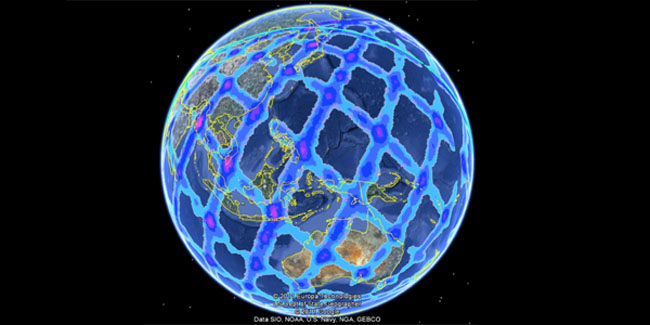A new approach to predicting spacecraft re-entry
 (Download Image)
This graphic is a probability density map overlaid on top of the Earth. Lab researchers calculated the probability of the location where the Russian Phobos-Grunt spacecraft would re-enter the Earth's atmosphere. Graphic by Deborah Dennison based on calculations made by Matt Horsley.
(Download Image)
This graphic is a probability density map overlaid on top of the Earth. Lab researchers calculated the probability of the location where the Russian Phobos-Grunt spacecraft would re-enter the Earth's atmosphere. Graphic by Deborah Dennison based on calculations made by Matt Horsley.
But this call was about something very different. The Russians had launched a mission to Phobos, one of the moons of Mars, in early November, but it failed to escape Earth's orbit. JSpOC asked if the Laboratory could help to predict where the spacecraft would return to Earth.
Under the direction of Alex Pertica, three Lab organizations -- the Lab's Space Situational Awareness team, the Homeland-Defense Operational Planning System and the National Atmospheric Release Advisory Center -- contributed to this effort.
Accurate prediction of spacecraft re-entries has long been challenging because the forces that act to slow down the satellite are complex and dynamic. The high altitude atmosphere is an important contributor to this force, and the composition of this atmosphere can change rapidly with changes in the sun's intensity. In order to model these effects correctly, it is important to understand how these contributing forces change over time.
First, Laboratory researchers developed the software infrastructure necessary to make a series of increasingly accurate predictions for the re-entry, and more importantly, to quantify the uncertainty in these predictions.
With the spacecraft orbiting the earth once every 90 minutes, making the uncertainty window as small as possible was critical, but understanding exactly how big the uncertainty window was as re-entry approached also was crucial.
Matt Horsley recognized the need to use high-performance computing to fully characterize these evolving uncertainties and to produce a series of probability density distributions for the re-entry time, and he knew he had about a month to do it.
With the software in place, about 10 days before re-entry, data began to arrive from the Air Force about the satellite's precise position. As re-entry approached, Horsley's probability distributions got smaller and smaller. Horsley's final prediction contained a probability distribution spanning about an hour, which bracketed the actual re-entry time with a mid-point that was within 20 minutes of the actual event.
Livermore worked with Sandia National Laboratories to complete the picture of the Phobos-Grunt descent. Horsley handled the prediction to the "pierce point," which is where the atmosphere becomes so dense that the object begins to break up. Sandia staff performed aerothermal modeling using Livermore trajectory data to continue the prediction to where the spacecraft would land on Earth's surface.
GIS expert Debbie Dennison at the Laboratory's Homeland-Defense Operational Planning System (HOPS) aided the Air Force by creating a 3-D visualization of the probability distributions by draping them over Google Earth. In addition, the National Atmospheric Release Advisory Center completed all advance planning necessary to perform plume modeling if Phobos-Grunt's fuel tanks came down intact over land.
The work performed by LLNL provided the Air Force with an unprecedented understanding of the evolving range of potential re-entry times and locations for the Phobos-Grunt satellite. In the end, the Phobos-Grunt spacecraft finally landed in the Pacific Ocean west of Chile on Jan. 15. The final prediction delivered by the LLNL team was made with data received from the Air Force more than two hours before re-entry. However, the predictions could have been even better -- Air Force data available at two hours prior to re-entry was received at LLNL too late to be incorporated into the final prediction.
The team developed a "post-diction," which indicated that had this data been received soon after it was available, the prediction would have resulted in a probability distribution spanning about 20 minutes, with a mid-point within just a few minutes of the actual re-entry time. Processes to enable more timely data transfer in the future are currently under consideration by the Air Force.
Contact
Katherine M Walter[email protected]
925-423-2688
Tags
Physical and Life SciencesFeatured Articles







